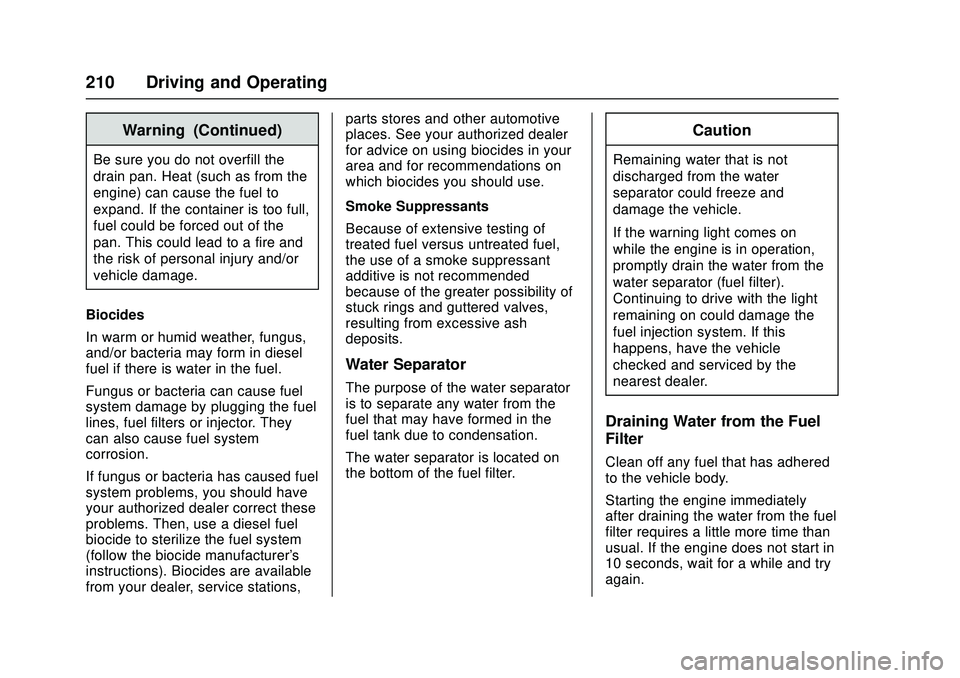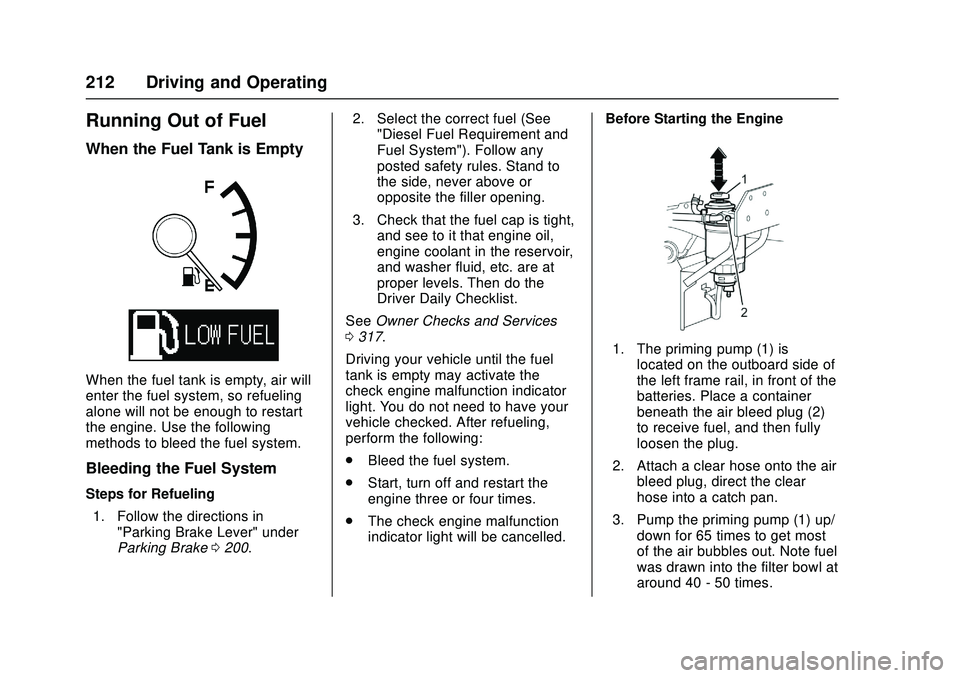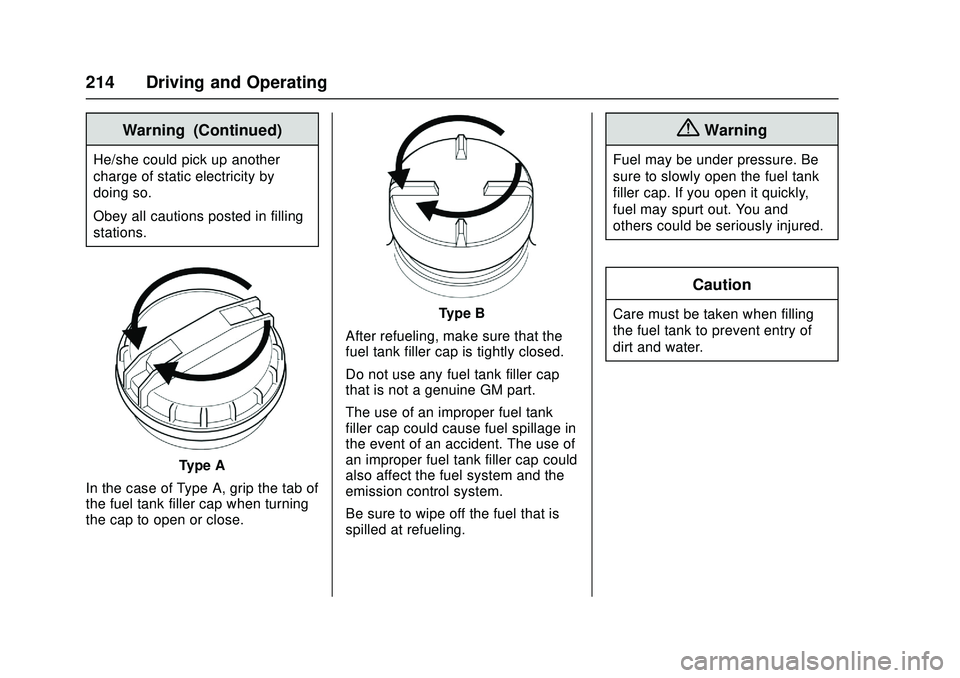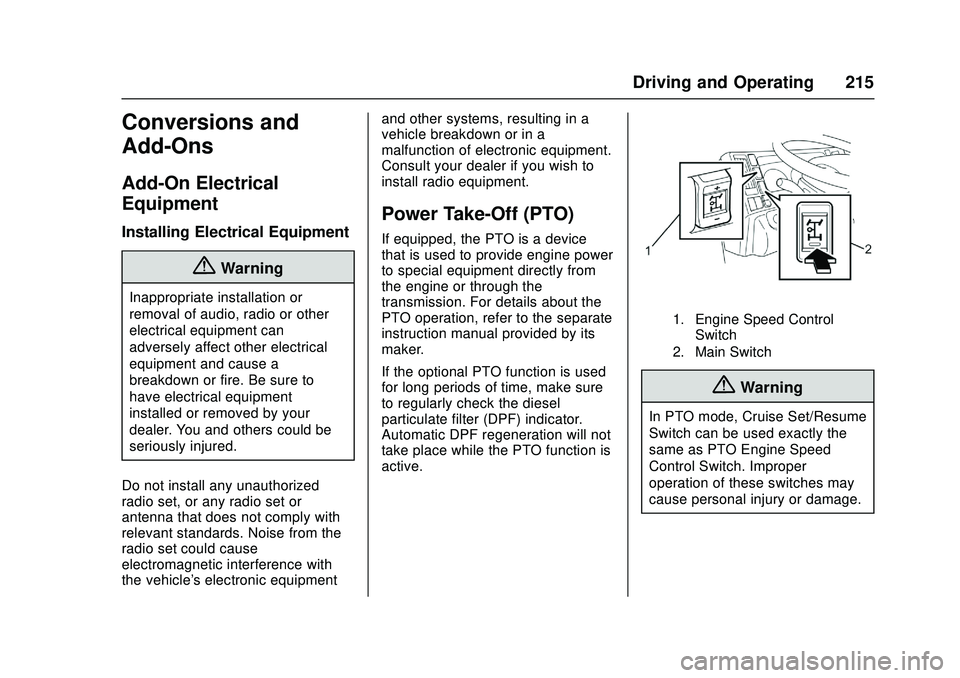CHEVROLET LOW CAB FORWARD 2018 Owner's Manual
Manufacturer: CHEVROLET, Model Year: 2018, Model line: LOW CAB FORWARD, Model: CHEVROLET LOW CAB FORWARD 2018Pages: 358, PDF Size: 6.32 MB
Page 211 of 358

Chevrolet Low Cab Forward Owner Manual (GMNA-Localizing-U.S.-
11254764) - 2018 - crc - 12/5/16
210 Driving and Operating
Warning (Continued)
Be sure you do not overfill the
drain pan. Heat (such as from the
engine) can cause the fuel to
expand. If the container is too full,
fuel could be forced out of the
pan. This could lead to a fire and
the risk of personal injury and/or
vehicle damage.
Biocides
In warm or humid weather, fungus,
and/or bacteria may form in diesel
fuel if there is water in the fuel.
Fungus or bacteria can cause fuel
system damage by plugging the fuel
lines, fuel filters or injector. They
can also cause fuel system
corrosion.
If fungus or bacteria has caused fuel
system problems, you should have
your authorized dealer correct these
problems. Then, use a diesel fuel
biocide to sterilize the fuel system
(follow the biocide manufacturer's
instructions). Biocides are available
from your dealer, service stations, parts stores and other automotive
places. See your authorized dealer
for advice on using biocides in your
area and for recommendations on
which biocides you should use.
Smoke Suppressants
Because of extensive testing of
treated fuel versus untreated fuel,
the use of a smoke suppressant
additive is not recommended
because of the greater possibility of
stuck rings and guttered valves,
resulting from excessive ash
deposits.
Water Separator
The purpose of the water separator
is to separate any water from the
fuel that may have formed in the
fuel tank due to condensation.
The water separator is located on
the bottom of the fuel filter.
Caution
Remaining water that is not
discharged from the water
separator could freeze and
damage the vehicle.
If the warning light comes on
while the engine is in operation,
promptly drain the water from the
water separator (fuel filter).
Continuing to drive with the light
remaining on could damage the
fuel injection system. If this
happens, have the vehicle
checked and serviced by the
nearest dealer.
Draining Water from the Fuel
Filter
Clean off any fuel that has adhered
to the vehicle body.
Starting the engine immediately
after draining the water from the fuel
filter requires a little more time than
usual. If the engine does not start in
10 seconds, wait for a while and try
again.
Page 212 of 358

Chevrolet Low Cab Forward Owner Manual (GMNA-Localizing-U.S.-
11254764) - 2018 - crc - 12/5/16
Driving and Operating 211
Fuel will be mixed in the drained
water. Dispose of it in a method
conforming to the regulatory
requirements in your state.
If the water separator (fuel filter)
requires frequent draining, have the
fuel system inspected at your
dealer.
Pre Fuel Filter (Chassis-side)1. Attach a plastic hose to the drain plug (2) on the bottom of
the chassis-side fuel filter and
put the other end of the hose in
a container placed beneath the
filter. 2. Loosen the drain plug and
move the priming pump (1) up
and down by hand between
10 and 20 times.
3. Fully tighten the drain plug (2) and move the priming pump (1)
several times.
Fuel Filter (Engine-side)1. Attach a plastic hose to the drain plug (2) on the bottom of
the engine-side fuel filter (1)
and put the other end of the
hose in a container placed
beneath the filter.
2. Loosen the drain plug andmove the priming pump up and
down by hand between 10 and
20 times.
3. Fully tighten the drain plug and move the priming pump several
times.
4. Test run the engine and check that there are no fuel leaks
from the drain plug of the
engine-side fuel filter. Also
check that the water separator
(fuel filter) warning light
stays off.
Page 213 of 358

Chevrolet Low Cab Forward Owner Manual (GMNA-Localizing-U.S.-
11254764) - 2018 - crc - 12/5/16
212 Driving and Operating
Running Out of Fuel
When the Fuel Tank is Empty
When the fuel tank is empty, air will
enter the fuel system, so refueling
alone will not be enough to restart
the engine. Use the following
methods to bleed the fuel system.
Bleeding the Fuel System
Steps for Refueling1. Follow the directions in "Parking Brake Lever" under
Parking Brake 0200. 2. Select the correct fuel (See
"Diesel Fuel Requirement and
Fuel System"). Follow any
posted safety rules. Stand to
the side, never above or
opposite the filler opening.
3. Check that the fuel cap is tight, and see to it that engine oil,
engine coolant in the reservoir,
and washer fluid, etc. are at
proper levels. Then do the
Driver Daily Checklist.
See Owner Checks and Services
0 317.
Driving your vehicle until the fuel
tank is empty may activate the
check engine malfunction indicator
light. You do not need to have your
vehicle checked. After refueling,
perform the following:
. Bleed the fuel system.
. Start, turn off and restart the
engine three or four times.
. The check engine malfunction
indicator light will be cancelled. Before Starting the Engine
1. The priming pump (1) is
located on the outboard side of
the left frame rail, in front of the
batteries. Place a container
beneath the air bleed plug (2)
to receive fuel, and then fully
loosen the plug.
2. Attach a clear hose onto the air bleed plug, direct the clear
hose into a catch pan.
3. Pump the priming pump (1) up/ down for 65 times to get most
of the air bubbles out. Note fuel
was drawn into the filter bowl at
around 40 - 50 times.
Page 214 of 358

Chevrolet Low Cab Forward Owner Manual (GMNA-Localizing-U.S.-
11254764) - 2018 - crc - 12/5/16
Driving and Operating 213
4. Fully retighten the air bleedplug (2) and wipe off any fuel
that may have adhered to the
plug or surrounding area.
5. Continue to operate the pump for 50 times.
6. Start the engine.
7. If the engine does not start, repeat steps 5 and 6 as
necessary until it does start.
After Starting the Engine 1. Without pressing the accelerator pedal, start the
engine.
2. After the engine has started, allow it to idle for about
5 seconds.
3. Fully press the accelerator pedal and increase the engine
speed to the maximum speed
for 10 seconds. (Repeat this
operation several times.)
Insufficient air bleeding can result in
faulty engine operation. Be sure,
therefore, to always carry out the
previous steps under "After starting
the engine".Filling the Tank
Be sure to obey the following
instructions when refueling the
vehicle:
. Stop the engine and close the
vehicle's doors and windows.
. Keep cigarettes and other
flames away from the vehicle.
. Before opening the fuel tank
filler cap, touch a metallic object
to discharge static electricity
from your body.
. When filling, place the nozzle
deeply into the fuel tank. If you
try to fill more fuel by pulling out
the nozzle from the fuel tank, the
fuel may spill out, thus causing
danger.
. Be sure to wipe off the fuel that
is spilled at refueling.{Warning
Fuel vapor is highly flammable.
Be careful not to inhale fuel vapor
when refueling the vehicle.
If you have a static charge
buildup on your body while
refueling the vehicle, a spark
caused by its discharge could
ignite the fuel, resulting in burns.
All parts of the refueling
procedure (from opening the fuel
tank filler cap to completing the
refueling and closing the fuel tank
filler cap) must be performed by
the same person.
Other people may be carrying
static electricity. Do not allow
them to approach the fuel filler.
The person performing the
refueling procedure must not
return to the seat in the cab
part-way through the procedure.
(Continued)
Page 215 of 358

Chevrolet Low Cab Forward Owner Manual (GMNA-Localizing-U.S.-
11254764) - 2018 - crc - 12/5/16
214 Driving and Operating
Warning (Continued)
He/she could pick up another
charge of static electricity by
doing so.
Obey all cautions posted in filling
stations.
Type A
In the case of Type A, grip the tab of
the fuel tank filler cap when turning
the cap to open or close.
Type B
After refueling, make sure that the
fuel tank filler cap is tightly closed.
Do not use any fuel tank filler cap
that is not a genuine GM part.
The use of an improper fuel tank
filler cap could cause fuel spillage in
the event of an accident. The use of
an improper fuel tank filler cap could
also affect the fuel system and the
emission control system.
Be sure to wipe off the fuel that is
spilled at refueling.
{Warning
Fuel may be under pressure. Be
sure to slowly open the fuel tank
filler cap. If you open it quickly,
fuel may spurt out. You and
others could be seriously injured.
Caution
Care must be taken when filling
the fuel tank to prevent entry of
dirt and water.
Page 216 of 358

Chevrolet Low Cab Forward Owner Manual (GMNA-Localizing-U.S.-
11254764) - 2018 - crc - 12/5/16
Driving and Operating 215
Conversions and
Add-Ons
Add-On Electrical
Equipment
Installing Electrical Equipment
{Warning
Inappropriate installation or
removal of audio, radio or other
electrical equipment can
adversely affect other electrical
equipment and cause a
breakdown or fire. Be sure to
have electrical equipment
installed or removed by your
dealer. You and others could be
seriously injured.
Do not install any unauthorized
radio set, or any radio set or
antenna that does not comply with
relevant standards. Noise from the
radio set could cause
electromagnetic interference with
the vehicle's electronic equipment and other systems, resulting in a
vehicle breakdown or in a
malfunction of electronic equipment.
Consult your dealer if you wish to
install radio equipment.
Power Take-Off (PTO)
If equipped, the PTO is a device
that is used to provide engine power
to special equipment directly from
the engine or through the
transmission. For details about the
PTO operation, refer to the separate
instruction manual provided by its
maker.
If the optional PTO function is used
for long periods of time, make sure
to regularly check the diesel
particulate filter (DPF) indicator.
Automatic DPF regeneration will not
take place while the PTO function is
active.
1. Engine Speed Control
Switch
2. Main Switch
{Warning
In PTO mode, Cruise Set/Resume
Switch can be used exactly the
same as PTO Engine Speed
Control Switch. Improper
operation of these switches may
cause personal injury or damage.
Page 217 of 358

Chevrolet Low Cab Forward Owner Manual (GMNA-Localizing-U.S.-
11254764) - 2018 - crc - 12/5/16
216 Driving and Operating
When Operating the PTO
For operation of special equipment,
see the manufacturer’s instructions.
Installations, or alterations to the
original equipment vehicle or
chassis, as manufactured and
assembled by General Motors, are
not covered by this warranty. The
body company, assembler,
or equipment installer is solely
responsible for warranties on the
body or equipment and any
alterations to any of the parts,
components, systems,
or assemblies installed by GM.
Examples include, but are not
limited to, special body installation,
such as recreational vehicles, the
installation of any non-GM part,
cutting, welding, or the
disconnecting of original equipment
vehicle or chassis parts and
components, extension of the
wheelbase, suspension, and
driveline modifications, and axle
additions. The engine control module (ECM)
has the ability to accommodate one
of three different PTO modes. Each
mode can be programmed to
accommodate many PTO devices.
Optional PTO switches are available
from your dealer to ease installation
of a PTO.
The optional PTO main switch and
PTO engine speed control switch
can be used increase the engine
idle r/min without additional
programming. Pressing the PTO
main switch once will activate the
PTO mode and raise the idle up
speed up to the preset 800 r/min.
Once in PTO mode the PTO engine
speed control switch can be used to
adjust the idle speeds between the
preset 1,300 and 1,700 r/min.
Moving the selector lever from park
or neutral, applying the brake pedal
or releasing the parking brake will
cancel PTO mode and return the
engine idle speed to normal. For
additional details about PTO
programming, contact your dealer.
Page 218 of 358

Chevrolet Low Cab Forward Owner Manual (GMNA-Localizing-U.S.-
11254764) - 2018 - crc - 12/5/16
Vehicle Care 217
Vehicle Care
General Information
General Information . . . . . . . . . . 218
California Proposition65 Warning . . . . . . . . . . . . . . . . . 218
California Perchlorate Materials Requirements . . . . . 218
Accessories and Modifications . . . . . . . . . . . . . . . . 218
Vehicle Checks
Doing Your OwnService Work . . . . . . . . . . . . . . . 218
Cab Tilting . . . . . . . . . . . . . . . . . . . . 220
Engine Compartment Overview . . . . . . . . . . . . . . . . . . . . 222
Engine Cover . . . . . . . . . . . . . . . . . 222
Engine Oil . . . . . . . . . . . . . . . . . . . . 223
Automatic Transmission Fluid . . . . . . . . . . . . . . . . . . . . . . . . 229
Engine Air Cleaner/Filter . . . . . . 231
Engine Coolant . . . . . . . . . . . . . . . 231
Engine Overheating . . . . . . . . . . 237
Power Steering Fluid . . . . . . . . . 240
Washer Fluid . . . . . . . . . . . . . . . . . 241
Brakes . . . . . . . . . . . . . . . . . . . . . . . 242
Brake Fluid . . . . . . . . . . . . . . . . . . . 246
Battery . . . . . . . . . . . . . . . . . . . . . . . . 247
Fuel Filter . . . . . . . . . . . . . . . . . . . . 248 Rear Axle (Gear Oil Viscosity
Chart) . . . . . . . . . . . . . . . . . . . . . . . 249
Rear Axle (Oil Level Check) . . . . . . . . . . . . . . . . . . . . . . 249
Noise Control System . . . . . . . . 250
Automatic Transmission Shift
Lock Control Function
Check . . . . . . . . . . . . . . . . . . . . . . . 251
Wiper Blade Replacement . . . . 252
Headlamp Aiming
Headlamp Aiming . . . . . . . . . . . . 254
Bulb Replacement
Bulb Replacement . . . . . . . . . . . . 254
Headlamps and Front Turn Signal . . . . . . . . . . . . . . . . . . . . . . . 257
Roofmarker Lamps . . . . . . . . . . . 261
Sidemarker Lamps (Including Turn Signal and Cornering
Lamps) . . . . . . . . . . . . . . . . . . . . . . 261
Taillamps, Turn Signal, Stoplamps, and Back-Up
Lamps . . . . . . . . . . . . . . . . . . . . . . 263
License Plate Lamp . . . . . . . . . . 263
Interior Lamps . . . . . . . . . . . . . . . . 264
Electrical System
Electrical System Overload . . . 264
Wheels and Tires
Wheels and Tires . . . . . . . . . . . . . 272 Tire Pressure . . . . . . . . . . . . . . . . . 284
Tire Rotation . . . . . . . . . . . . . . . . . 284
If a Tire Goes Flat . . . . . . . . . . . . 287
Jump Starting
Jump Starting - North
America . . . . . . . . . . . . . . . . . . . . . 287
Towing the Vehicle
Towing the Vehicle . . . . . . . . . . . 291
Appearance Care
Exterior Care . . . . . . . . . . . . . . . . . 293
Interior Care . . . . . . . . . . . . . . . . . . 299
Page 219 of 358

Chevrolet Low Cab Forward Owner Manual (GMNA-Localizing-U.S.-
11254764) - 2018 - crc - 12/5/16
218 Vehicle Care
General Information
Your authorized dealer has trained
technicians and genuine parts to
service your vehicle properly. For
expert advice and quality service,
see your authorized dealer.
California Proposition
65 Warning
Most motor vehicles, including this
one, as well as many of its service
parts and fluids, contain and/or emit
chemicals known to the State of
California to cause cancer and birth
defects or other reproductive harm.
Engine exhaust, many parts and
systems (including some inside the
vehicle), many fluids and some
component wear by-products
contain and/or emit these
chemicals.
California Perchlorate
Materials Requirements
Certain types of automotive
applications, such as airbag
initiators, seat belt pretensioners,
and lithium batteries contained inremote keyless transmitters, may
contain perchlorate materials.
Special handling may be necessary.
For additional information, see
www.dtsc.ca.gov/hazardouswaste/
perchlorate.
Accessories and
Modifications
Factory-Approved Accessories
Your dealer can furnish a wide
range of comfort, convenience, and
safety accessories, especially
designed for you and your new
truck. They can install all of the
safety accessories you will need to
comply with local, state and D.O.T.
regulations and advise you how to
comply with these regulations.
Be sure to ask your authorized
dealer about the accessories.
Vehicle Checks
Doing Your Own
Service Work
Precautions for Checking and
Adjustments
Your authorized dealer has trained
technicians and genuine parts to
service your vehicle properly. For
expert advice and quality service,
see your authorized dealer.
{Warning
To help avoid personal injury, take
care when doing any
maintenance or making any
check or repair. Follow
manufacturer's instructions for all
materials used during service and
maintenance of this vehicle.
If used or handled improperly,
they may be hazardous. Improper
or incomplete service can also
affect the vehicle and result in
personal injury, or damage to the
(Continued)
Page 220 of 358

Chevrolet Low Cab Forward Owner Manual (GMNA-Localizing-U.S.-
11254764) - 2018 - crc - 12/5/16
Vehicle Care 219
Warning (Continued)
vehicle or its equipment. If you
have any questions about
carrying out some service, have
the work done by a skilled
technician.
To prevent personal injury, keep
hands, tools and clothing clear of
the engine cooling fan when the
engine is running.
The engine, exhaust pipe and
radiator will be hot immediately
after the vehicle is driven. Be
careful around these parts to
prevent burns. Perform all checks
when the engine is cold.
Do not perform work near an
open flame or other heat sources.
Do not let the engine run in poorly
ventilated garages or sheds. This
could cause carbon monoxide
poisoning.(Continued)
Warning (Continued)
Performing maintenance work on
a truck or chassis can be
dangerous. In trying to do some
jobs, you can be seriously injured.
Do your own maintenance work
only if you have the required
know-how and the proper tools
and equipment for the job. If you
have any doubts, contact your
dealer.
You and others could be seriously
injured.
Pull firmly on the parking brake
lever and move the selector lever to
"P" and make sure the shift indicator
displays "P".
Make sure to turn off the engine and
remove the key from the engine
control switch before performing any
checks.
Select a place with a solid and level
surface to perform the checking and
maintenance work. Make sure to chock the wheels. It would be very
dangerous if the vehicle started
to move.
When performing work on the
electrical system, begin by turning
the engine control switch to the
"LOCK" position, wait at least
3 minutes, and then disconnect the
negative cable from the negative
terminal on battery. If the negative
cable is disconnected within
3 minutes, the engine control
module may malfunction.
When working on the fuel line or
fuel filter, remove the fuel tank filler
cap. The fuel system is under
pressure and the fuel will overspill
unless the pressure is relieved,
possibly leading to combustion or
a fire.
Do not make engine adjustments
yourself. Be sure to consult your
dealer.
Use only appropriate tools.
Oils, brake fluid and engine coolant
have lubrication, cooling and rust
prevention functions. If these liquids
deteriorate through loss or